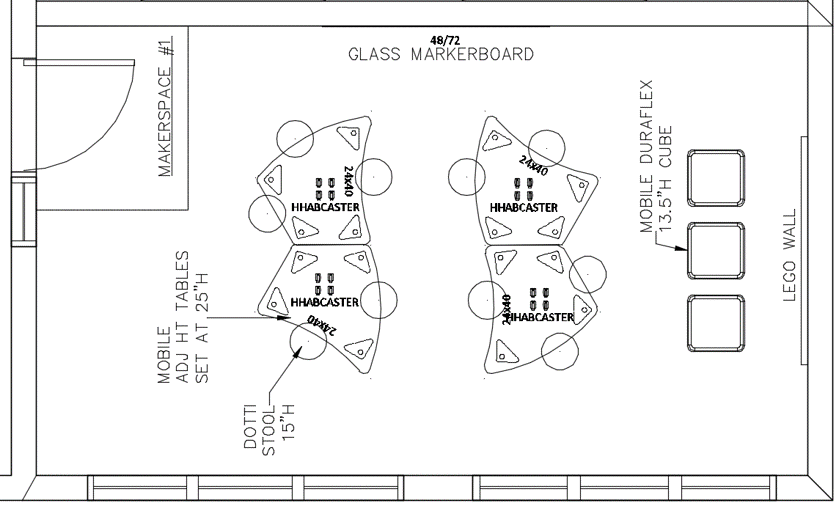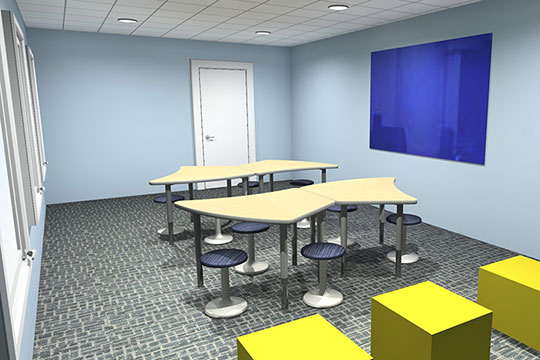It’s Yours for the Making: Putting Makerspaces to Work in Your School
Cristel Hutchinson and Elizabeth Bower
Photo credit: HMC Architects
If you work in the world of education, you’ve probably heard a lot of buzz about makerspaces in recent years. But what you may not have heard, is a breakdown of what makes makerspaces powerful and the many design considerations necessary for creating a successful one.
What is a Makerspace?
Let’s start by defining what a makerspace is. Like beauty, a makerspace is in the eye of the beholder. The term “makerspace” has been used almost interchangeably with the terms “hackerspace,” “fab lab,” “innovation lab” and “learning lab,” but there are distinctions that make each space definitively unique. The distinctions can largely be made by the tools used in the space. For example, a typical fabrication lab might use wood and nails, while a hackerspace might use laptops, and an innovation lab might use 3-D printers.
It’s hard to define what a makerspace is — precisely because it can be so many different things, but there are a few hard and fast criteria.
Makerspaces in schools may be part of science, technology, engineering and math (STEM) education. They may also be part of “think tanks” or incubators for business startups. Makerspaces can be high-tech and include equipment such as 3-D printers, laser cutters or soldering irons. They could also include low-tech building blocks such as paper, gears and connectors. Makerspaces might be located inside a school or library or be part of a business accelerator. Makerspaces may be open to students or entrepreneurs.
No matter what category it falls into, a makerspace is a workspace where visitors can explore interests and create things by trial and error.
The maker culture helps develop skills in problem solving, teamwork, critical thinking, deductive reasoning and perseverance. Participants learn by exploring concepts and seeing the practical results of their education — such as seeing how engineering concepts work in everyday life. It’s not just about what you know, but what you do with what you know. Making things follows an iterative process that includes the following steps: hypothesizing, testing, analyzing, refining and retesting.

Curriculum considerations:
If you have decided to create a makerspace in your school, congratulations! You’re in for an adventure and you have a blank or almost blank slate to work with. As exciting as it is to imagine a designer asking about whether you prefer fabric swatch A or B, crafting a flexible workshop to host a wide range of STEM creativity is no easy task. Asking the right questions about how the space will be used is a good start for establishing requirements.
What are your instructional goals?
- What would you like to see students learn in this space?
- How are you aligning your district’s instructional standards with the learning goals for this space?
- If your focus is on your students achieving future-ready skills, what skills are you striving for?
Who, how and when?
- What grade levels will be using the space?
- Are there ADA considerations within the student body?
- Is this space meant for specific academic subjects?
- Will you be opening this space to the public, parents or other schools?
- What type of activities do you see your students engaging in — self-directed or teacher-led?
Measuring success
- How will you evaluate and measure success?
- Do your formal and/or informal methods align with your instructional goals?

Design considerations:
What space do you have to work with? Makerspaces can be in classrooms, libraries, computer/science labs or transitional spaces, and they can start small. Often, they begin in libraries, which offer the bonus of equitable access.
Consider space and safety. Regardless of whether a design is open, closed, collaborative, formal or informal, safety should always come first. For example, what type of technology is the educator using, and how does that impact the space? Also, plan on plenty of space for students to move freely while they carry materials. Other key safety elements include lighting and ventilation, plus an easily accessible first aid kit.
How will the students work? Will students be seated at tables or standing? Will they need floor space or areas for ideation, like markerboards?
What tools and tech will you use? Makerspaces can be anywhere on the low-tech to high-tech spectrum. Low-tech tools might include paint, paper, cardboard, tape, popsicle sticks, glue, hammers, wire cutters, sewing machines or drills. Common high-tech tools include 3-D printers, computers, graphic design or video editing software, cameras, green screens, little bits, Makey Makeys and simple circuits.
What are your storage and power needs? Storage for materials and tools is essential, so think about the quantities, sizes and shapes of items to be stored. Also, does any expensive or fragile equipment need secure storage? A few often overlooked design considerations include whether students need to store backpacks or if cleaning supplies need to be stored within the makerspace. How about a display area for your projects? Last, but certainly not least, be sure to plan for power needs.
There is little doubt that extensive planning and trial and error go into designing great makerspaces. But rest assured, the time is well-spent. If you need help making sure that you have all the bases covered, reach out to us — we’re here to help! Find out more about the educational furniture providers at ODP Business Solutions Workspace Interiors®.
ODP and ODP Business Solutions are trademarks of ODP Business Solutions, LLC. © 2026 ODP Business Solutions, LLC. All rights reserved.